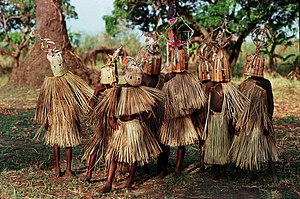WaYao
 9- to 10-year-old boys of the waYao tribe participating in circumcision and initiation rites (March 2005). |
|
| Total population | |
|---|---|
| (2 million) | |
| Regions with significant populations | |
| Malawi, Mozambique, Tanzania | |
| Languages | |
| Chiyao, Chichewa, Chitumbuka, Swahili, English, Portuguese | |
| Religion | |
| Islam |
The Yao people, Wayao, are a major Bantu ethnic and linguistic group based at the southern end of Lake Malawi, who played an important part in the history of Southeast Africa during the 19th century. The Yao are a predominantly Muslim people of about 2 million spread over three countries, Malawi, northern Mozambique, and in Ruvuma Region and Mtwara Region of Tanzania. The Yao people have a strong cultural identity, which transcends the national borders.
The majority of Yao are subsistence farmers. When Arabs arrived on the southeastern coast of Africa they began trading with the Yao people, mainly ivory, grains, and slaves in exchange for clothes and guns. Because of their involvement in this coastal trade they became one of the richest and most influential tribes in Southern Africa. Large Yao kingdoms came into being as Yao chiefs took control of the Niassa province of Mozambique in the 19th century. During that time the Yao began to move from their traditional home to today's Malawi and Tanzania, which resulted in the Yao populations they now have. The most important result of the chiefdoms was the turning of the whole nation to Islam around the turn of the 20th century and after World War I. Because of their trade with the Arabs and Swahili, the Yao chiefs (sultans) needed scribes who could read and write. The Islamic teachers who were employed and lived in the Yao villages made a significant impact on the Yao people because they could offer them literacy, a holy book, religious clothes, and square, instead of round, houses. Furthermore, the Yao sultans strongly resisted Portuguese, British, and German colonial rule, which was viewed as a major cultural and economic threat to them. The British tried to stop the ivory and slave trade by attacking some of the Yao trade caravans near the coast. The Yao chief Mataka rejected Christianity, as Islam offered them a social system which would assimilate their traditional culture. Because of the political and ritual domination of the chiefs, their conversion to Islam caused their subjects to do likewise. The Folk Islam which the Yao people have embraced is syncretized with their traditional animistic belief system.
...
Wikipedia
